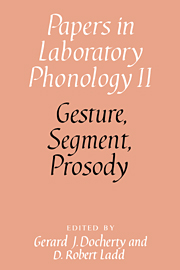Book contents
- Frontmatter
- Contents
- List of contributors
- Acknowledgments
- Introduction
- Section A Gesture
- Section B Segment
- Section C Prosody
- 13 An introduction to intonational phonology
- 14 Downstep in Dutch: implications for a model
- 15 Modeling syntactic effects on downstep in Japanese
- 16 Secondary stress: evidence from Modern Greek
- Appendix 1 The test phrases (bold type) of experiment 1 in the context in which they were read
- Appendix 2 The distractors (bold type) of experiment 1 in the context in which they were read
- Appendix 3 The test sentences of experiment 2. The test words are in bold type
- Appendix 4 The distractor sentences of experiment 2. The distractors are in bold type
- References
- Name index
- Subject index
16 - Secondary stress: evidence from Modern Greek
from Section C - Prosody
Published online by Cambridge University Press: 18 December 2009
- Frontmatter
- Contents
- List of contributors
- Acknowledgments
- Introduction
- Section A Gesture
- Section B Segment
- Section C Prosody
- 13 An introduction to intonational phonology
- 14 Downstep in Dutch: implications for a model
- 15 Modeling syntactic effects on downstep in Japanese
- 16 Secondary stress: evidence from Modern Greek
- Appendix 1 The test phrases (bold type) of experiment 1 in the context in which they were read
- Appendix 2 The distractors (bold type) of experiment 1 in the context in which they were read
- Appendix 3 The test sentences of experiment 2. The test words are in bold type
- Appendix 4 The distractor sentences of experiment 2. The distractors are in bold type
- References
- Name index
- Subject index
Summary
Introduction
The need to express formally stress subordination in English has always been felt and many attempts to do so have been made, e.g. Trager and Smith (1951), Chomsky and Halle (1968). However, until the advent of metrical phonology (Liberman and Prince 1977) all models tried to express stress subordination through linear analyses. The great advantage of metrical phonology is that by presenting stress subordination through a hierarchical structure it captures the difference in stress values between successive stresses in an economical and efficient way.
When Liberman and Prince presented their model, one of their intentions was to put forward a “formalization of the traditional idea of ‘stress timing’” (1977: 250) through the use of the metrical grid. This reference to stress-timing implies that their analysis mainly referred to the rhythm of English. However, the principles of metrical phonology have been adopted for the rhythmic description of other languages (Hayes 1981; Hayes and Puppel 1985; Roca 1986), including Polish and Spanish, which are rhythmically different from English. The assumption behind studies like Hayes (1981) is that, by showing that many languages follow the same rhythmic principles as English, it can be proved that the principles of metrical phonology, namely binarity of rhythmic patterns and by consequence hierarchical structure, are universal. However, such evidence cannot adequately prove the universality of metrical principles; what is needed is evidence that there are no languages which do not conform to these principles.
- Type
- Chapter
- Information
- Gesture, Segment, Prosody , pp. 398 - 419Publisher: Cambridge University PressPrint publication year: 1992
- 8
- Cited by

